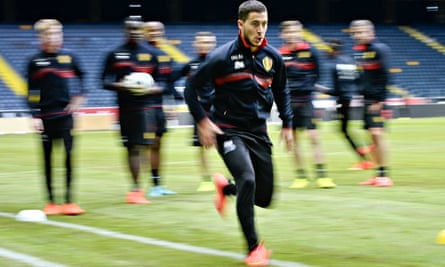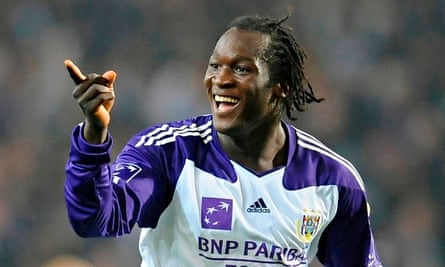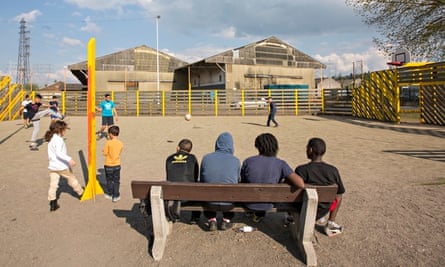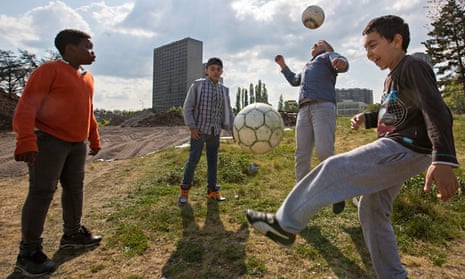Not everything that Michel Sablon writes down goes to plan. At Italia 90, Sablon was part of Belgium’s coaching staff, and a couple of minutes before the end of extra time in their last-16 match against England, he compiled a list of the penalty-takers. He had just finished scribbling the names when David Platt, in one of those iconic World Cup moments, spectacularly hooked the ball past Michel Preud’homme. “A great goal by Platt. But I was so disappointed,” Sablon says. “I threw the list away.”
A little more than a decade later Sablon started with another blank piece of paper, this time with the intention of revolutionising Belgian football in his role as the federation’s new technical director. At its headquarters in Brussels, Sablon proudly hands over a copy of the original blueprint, dated September 2006 and titled “La vision de formation de l’URBSFA”. He smiles when asked whether going to this summer’s World Cup finals as fifth favourites was what he had in mind. “For sure, no”.
Belgium’s emergence as one of the strongest nations in world football has exceeded all expectations. A country with a population of only 11m, with just 34 professional clubs competing across two leagues, has produced – and there are no reservations in Belgium about using this term because it is widely accepted as the only description befitting of their talent pool – a golden generation of footballers.
Marc Wilmots’ 23-man squad for the World Cup is replete with stellar names, players who have changed hands for hundreds of millions of pounds and in the majority of cases belong to Premier League clubs. It is also a group that could stay together for years to come – all but six are aged 27 and under. Daniel van Buyten, the Bayern Munich defender, is the only player in his 30s. “It’s excellent,” Sablon says. “But when those guys come together in one group, I think it’s a little bit lucky also.”

For the federation, the watershed moment came in 1998 when Belgium were eliminated at the group stage at the World Cup finals in France. Bob Browaeys, who has coached Belgium youth teams at every level and played a major part in putting together Sablon’s blueprint, says there was “no unified vision on youth” at that point. He remembers 30 federation coaches, drawn from the Dutch- and French-speaking parts of the country, meeting to discuss a radical change in approach.
“You have to know that at the end of the 90s in Belgium, they all played with individual marking, sometimes with a sweeper, it was 4-4-2, it was even 3-5-2, we got a lot of results with our A team, because we played very organised. But it was defensive, a culture of counter-attack,” Browaeys says.
Tapping into philosophies and training methods in the national setups in Netherlands and France, their neighbours in the north and south, as well as at clubs such as Ajax and Barcelona, Browaeys and his colleagues proposed that every Belgium youth team would play 4-3-3 and that work should begin on producing a totally different type of player.
“It was a massive shift but we believed that 4-3-3, at that moment, was the strongest learning environment for our players,” Browaeys says. “We felt that we had to develop dribbling skills, we said at the heart of our vision was 1v1, the duel. We said when a boy or girl wants to start playing football, you must offer first the dribble, let them play freely.”
By the time Sablon took over as acting technical director in 2001, there was a playing philosophy but little in the way of structure. Sablon provided that and more. His arrival was also well-timed. Belgium had just co-hosted Euro 2000 with the Netherlands and, although they played poorly and failed to get out of their group, they made a tidy profit off the field.
Sablon made sure a chunk of that money was invested in youth development. A new national football centre was built in Tubize, on the outskirts of Brussels. The number of people enrolling on the entry-level coaching course increased tenfold after the federation made it free. Double PASS, a subsidiary of the University of Brussels, were appointed to audit all the youth systems at club level and make recommendations (the Premier League started using the same company nine years later).
Around the same time Sablon commissioned the University of Louvain to carry out an extensive study on youth football in Belgium, which involved filming 1,500 matches across different age groups. He had worked closely with the clubs for some time, holding regular meetings with academy directors to exchange ideas and encourage them to contribute towards the changing face of Belgian football, but not everyone was convinced.
The university’s results, Sablon says, were a turning point. “That’s why we started with scientific analysis. If we showed the clubs the figures of young boys and girls playing at under-eight and under-nine, and they touched the ball twice in half an hour, no one can say that it’s good. We had the proof. We had the figures. And this was people who were known in football. The guy who made the analysis, Werner Helsen, was a player and a coach in the second division, so he’s a professor in university but also a real football man.”

One of the findings in the university research was that there was far too much emphasis on winning and not enough on development. There was also evidence to support the federation’s theory that 2v2, 5v5 and 8v8 were the best small-sided games to encourage children to practise the skills – dribbling and diagonal passing – that were central to their philosophy of playing 4-3-3.
Determined to get the message through at all levels of the game, Sablon delivered more than 100 presentations. “I gave an explanation with videos and everything. And then I went to the pitch with the coaches who were preparing the boys. It was about four hours in total,” he says.
“On one occasion I said to a president: ‘I don’t start [this presentation].’ He said: ‘What’s happened?’ I said: ‘I asked the clubs not to put up the rankings for the small boys, from under-7 and under-8.’ Can you imagine what it was like with 300 people in the hall waiting? They moved the rankings with hammers and nails. I said to them afterwards: ‘Rankings is the wrong way. Make the development of your players the first objective.’”
There were also problems to contend with inside the federation when results suffered. “I was responsible for all national teams and we played 4-3-3 from one season to another,” Sablon says. “We lost games, people said: ‘Why did we change it?’ I was once a member of the executive committee, it was an advantage – I could convince people at the top of the federation. Some would shoot me of course, they said: ‘You are crazy.’ They said: ‘We play European Championship and you pay more attention to the playing system than to be qualified.’
I said: ‘Yes, you are completely right.’”
Although Eden Hazard, Thomas Vermaelen and Jan Vertonghen left Belgium as teenagers to continue their football education abroad, crucially the federation was able to have a direct influence on the development of the majority of the country’s elite players.
A joint initiative with the government saw eight Topsport schools introduced between 1998 and 2002, with the aim of providing the most talented boys and girls, aged between 14 and 18, with additional training during the normal curriculum to increase their chances of reaching the top. Those sessions – four mornings a week and two hours at a time – continue to be taken by coaches that work for the federation.
The premise behind it is not dissimilar to the Football Association’s former national school at Lilleshall, which closed in 1999 because of the introduction of Premier League academies, except the Belgian system has a couple of major advantages. With eight Topsport schools dotted around a small country, the players selected are able to commute from home, the corollary being that they are free to train with their clubs four times a week in the evening.
All of which meant that the selected players were receiving twice as much coaching as they did before. As for the success rate, seven of the World Cup squad – Thibaut Courtois, Dries Mertens, Kevin de Bruyne, Mousa Dembélé, Steven Defour, Axel Witsel and Nacer Chadli – came through a system that many of Belgium’s leading clubs have now replicated by collaborating with local schools to increase contact time with their own players.
Jean Kindermans provides a tour of one of the two schools in Brussels that Anderlecht use as part of their “Purple Talents” project, which was launched in 2007 and counts Romelu Lukaku among its graduates. Kindermans, Anderlecht’s director of youth, says that the three-times-a-week one-hour training sessions at school, which are exclusively based on the development of technical skills, have made a huge difference.

“My ambition was to have more hours to develop young boys,” he says. “Lukaku, you have to know, we took him when he was under-13. He was a good player but not very good technically. He was fast and strong but we had to polish him.”
Education, though, is not allowed to suffer. At the start of the morning session Kindermans welcomes back a group of academy players who were prevented from training at school for a period because their grades dropped off. He explains how he believes Anderlecht have a duty of care that stretches beyond trying to produce another Vincent Kompany or Lukaku.
“In Anderlecht, every day 220 young guys, from under-six to under-21, are dreaming about a future professional career. Explain to me how many from the 220 are going to reach professional level? Maximum 10%. When you are not a good educator, you say the 200 guys that will not reach a professional level is not my problem. I say: ‘Yes, it is my problem.’ We have to tell them that if they don’t reach professional level, because of injury, confidence, bad development, a family situation, if you stay in Anderlecht as long as possible, you will have a degree at school that will give you the opportunity to find a job, to be a human being with intellectual skills.”
While Kindermans praises the work that has gone on within the national setup – he describes Sablon as a “brilliant visionary” – he believes “there is no unique factor that is influencing the good period of the Belgian team”. He is also quick to stress – and these views are later repeated at Genk – that Anderlecht “don’t blindly follow what the federation is asking us”.
By way of example, Kindermans points out that Anderlecht play 3-4-3, rather than the federation’s favoured 4-3-3, up until the age of 14. He offers an interesting explanation for that decision. “Every time we play a match we try to have 70% of possession. So it means if you are going to play with four defenders, you are going to put them at an early age in a comfortable situation. We are playing with three defenders at a lower age to put them in difficulty.”
His commitment to developing footballers, in the purest sense, is absolute. “You have to know that tackling is forbidden in Anderlecht. You can only anticipate or intercept, till they come to Under-21 team, in the second team of Anderlecht,” Kindermans says. “Our main motivation is we want to create technically skilled football players. If our centre-backs try to provide a solution by tackling and putting the ball out, I don’t like it. I want to educate as good as possible: ‘When do I have to anticipate? When do I have to drop off?’ I want to create intelligent players, not butchers.”
He also wants to be able to keep hold of those intelligent players for longer – something that has become increasingly difficult over the last few years, when Belgium’s rise to prominence has coincided with foreign clubs, in particular those from the Premier League, trying to sign the next generation of stars earlier and earlier. The worry is not just for the club that loses the player but what the long-term implications are for the national team if a promising talent is denied the chance to play first-team football at a young age.
“Our philosophy in Anderlecht is to be a trampoline for Europe. We only ask one thing: let us educate,” Kindermans says. “Let us have one, two, three years of sportive reward before leaving. Not leaving at 14 or 15 years old, because I think you [the player] take a big risk and we are disappointed.
“We lost a player [Ismail Azzaoui] recently. We proposed him a contract for three years at the age of 16. I felt he was waiting. And in March I received a message from his father, thanking us for the good job we did with him for the last four or five seasons, telling us he’s leaving the club immediately for a foreign club. Now we know that it is Tottenham. So I have difficulties with that.
“Today the difficulty for young Belgian players is to resist ... when I see [Adnan] Januzaj has left, [Charly] Musonda has left to join Chelsea, Mathias Bossaerts has left to Manchester City, Azzaoui left to Tottenham, I am afraid that if every year Anderlecht is losing one, two or three players of our youth education, we are going to work hard but not get the rewards.
“The compensation is small. For Januzaj it was €550,000. It’s Uefa rules. And Manchester United were quite polite, because they gave more than they had to give, because it was an amazing talent. I remember that people from the [Anderlecht] board said: ‘Oh, nice job for a 16-year-old boy.’ I said: ‘Today, this may be good, we are proud that we can take €550,000. But what if within two, three or four years he will play in the Manchester United first team?’ And today maybe you can ask for 50 times more.”
At Genk, Roland Breugelmans, who has worked for the club for 25 years and been in charge of the youth setup for the majority of that time, echoes Kindermans’ sentiments. An entire corridor on the ground floor of Genk’s academy building is decorated with pictures of players who have come through their youth system, including three of the World Cup squad – Defour, De Bruyne and Courtois – yet so many are gone in the blink of an eye. Siebe Schrijvers, a talented 17-year-old forward, could be the next off the production line.Breugelmans is frustrated but also realistic.
“When a young player has an offer from England, we cannot win. We try to say to our players, stay until the end of school in Belgium, when you are 18, and after you have your diploma you can go to other countries when you have a lot of qualities. But we also have young players going to England at 16 years old, when the parents think: ‘Oh, it’s a lot of money.’ And it is a lot of money, €100,000 for one year. We give €10,000 for one year.”
In terms of the broader picture, Breugelmans maintains that the contribution that certain clubs have made to the health of Belgian football should not be overlooked. “I don’t like the federation saying: ‘With the system of our sport schools, that is the basis of the success now of our national team,’” he says. “I think everybody tried to give something to the player, the club and the federation.”
In Droixhe, a desperately poor neighbourhood on the northern fringes of Liège, another side to the story behind Belgium’s footballing renaissance is told – one that just about everyone in the country agrees has had a major impact on the fortunes of the national team.
First impressions are bleak when the No17 bus reaches the end of its journey from the centre of Liège. Ugly high-rise flats circle the area, rubbish litters the streets and a pushchair is half-submerged in a pond. One of the tower blocks is empty after being declared unsafe. Another two have been demolished, leaving a pile of rubble and an area of wasteland where a group of young boys are showing off their ball-juggling skills.
Droixhe is an area largely home to immigrants, chronically lacking in investment, high in crime and low in prospects – apart from when it comes to football. The gravel court where four teenagers are tearing around in the sunshine is the same makeshift pitch that Christian Benteke, Witsel and Zakaria Bakkali played on when they were growing up in Liège. All three have gone on to play for Belgium. All three also have multicultural roots, which is the case with so many of the players whoWilmots has taken to Brazil. They are inspirational figures to the children playing football in the streets and help to unite what can often feel like a fragmented country.

“It’s not easy for the kids here,” says Kismet Eris, a former community worker in Droixhe, who runs his own football academy in Liège and also represents Benteke. “They don’t have the same chances as the other ones, and that’s why they’re so proud of the national team, because now they are also accepted as Belgian people, because they see some of their own playing for the national team. A few years ago it was not like that. Now it is more open. With the national youth teams, you can see that you’ve got a lot of children of immigrants, or former refugees, representing Belgium. It’s also the country – the country is people like Christian, [Marouane] Fellaini, Axel Witsel, [Jan] Vertonghen, who is Flemish, Courtois, a Walloon. That’s the typical image of Belgium.”
Belgium, as those involved in football in the country are quick to point out, have achieved nothing yet other than qualify for their first major tournament in 12 years and restore some pride. Their progress, though, is indisputable and, furthermore, everything seems to be in place to ensure they keep getting better. Brazil may just be the start.
“It’s going to be the first time this team is going to play in that type of environment,” says Steven Martens, the secretary general at the Belgium FA. “Can they do that? Absolutely they can. Will they do that? It’s very hard to say. Will they do something remarkable over the next two, three World Cups and European Championships? I am absolutely convinced.”

